For its overdue celebratory gala to mark a century and a half of Britain’s sole-surviving rail-connected roundhouse, the Barrow Hill Engine Shed Society looked back 45 years to the day when its depot was still run by British Rail, which held a popular annual open day for visitors, reports Robin Jones in words and pictures.

There is no doubt that the preservation of Barrow Hill Roundhouse ranks among the pinnacles of achievements of the UK heritage sector.
Britain’s sole-surviving rail-connected roundhouse has over the past three decades evolved from a redundant artefact from a long bygone age into a vibrant multipurpose visitor attraction offering a now unique perspective on both the distant and recent past, with an interior that can be changed in an instant to accurately recreate the glories and fascination of either its steam or diesel and electric eras.
Enjoy more Heritage Railway reading in the four-weekly magazine.
Click here to subscribe & save.
Now widely recognised as a true gem of the Derbyshire town that it was built to serve 152 years ago, Barrow Hill Roundhouse came within 48 hours of meeting the same fate as far too many other treasures of Britain’s railway heritage.
Saving it from demolition with the clock at one minute to midnight was local enthusiast Mervyn Allcock, who, at the age of 23, was shocked to hear that BR not only planned to close it, but demolish it too – and responded with unswerving determination to save it.
Mervyn formed what became the Barrow Hill Engine Shed Society, and after successfully lobbying Chesterfield Borough Council, a preservation order was placed on the classic structure within hours of the demolition contractors preparing to move in. The granting of Grade II-listed status by the Department of the Environment in February 1991 came as a major triumph against perceived odds.
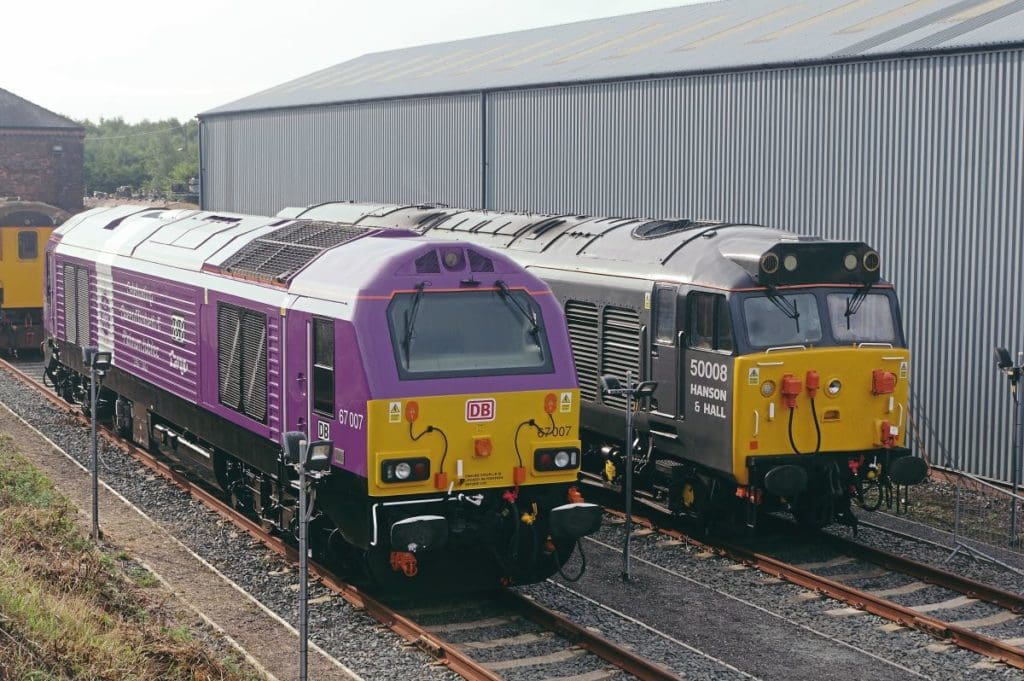
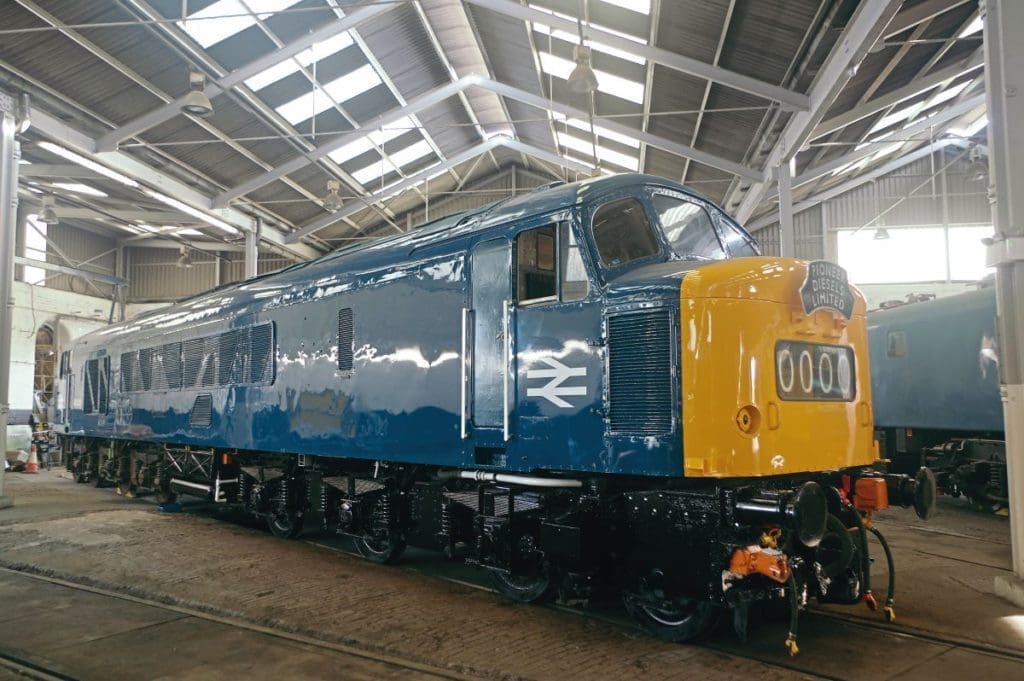
Back in time
The origins of this magnificent structure lay in the arrival of the North Midland Railway in Staveley in 1841 and the opening of the original Barrow Hill station. Subsequently renamed Barrow Hill & Staveley Works, an adjacent engine shed capable of housing four locomotives was built nearby in 1865.
The next year the Midland Railway agreed with Staveley Works to buy and operate its internal private railway for 100 years. The resulting increase in traffic necessitated the presence of more locomotives and a much larger shed – and so work on building the 24-road roundhouse began in 1869. It was built to a standard Midland Railway square shed design with a central turntable under cover.
Opening in 1870, the roundhouse remained in continuous use for 121 years, despite closing to steam on October 4, 1965. Until 1948 it was known as Staveley engine shed and then became known as Barrow Hill to avoid confusion with the nearby former Great Central Railway shed. For several years under BR ownership, a popular depot open day for the public was held every year.
The final day of operation was February 9, 1991, the last movements involving Class 20 Nos. 20197 and 20073 and Class 56 Nos. 58016 and 58027. However, history would record that all would not be lost, for two years earlier, Mervyn had formed his campaign group.
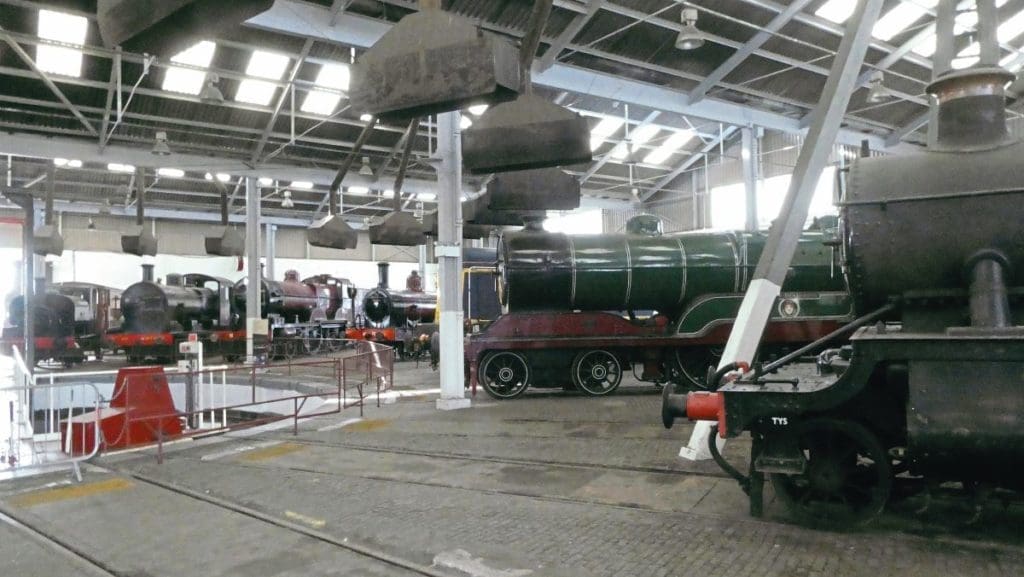
The listing of the roundhouse was pivotal but only the first step in a long process that saw the building neglected and vandalised. Following several years of talks, Chesterfield Borough Council completed the purchase of the roundhouse from the BR Property Board on December 20, 1996, paving the way for its refurbishment by volunteers with grant aid from several quarters.
July 1998 saw the roundhouse reopen to the public, who were treated to the spectacle of four steam engines inside. One of them was LMS Johnson ‘half cab’ 0-6-0T No. 41708 of 1880, the sole-surviving long-term resident of the shed between 1947 and 1965, and it gave public brake van rides.
A second open event was held on December 12/13, with several examples of diesel and electric locomotives alongside steam. Class 55 Deltic D9009 Alycidon ran, fresh from its eight-year rebuild.
January 16, 1999, added another heritage-era dimension with the arrival at Chesterfield of the ‘Barrow Hill Collier’ railtour from London, steam-hauled from Nottingham by Stanier 8F 2-8-0 No. 48773 and visiting several colliery lines.
Passengers were brought to the roundhouse from Chesterfield station by bus, but the 8F arrived under its own steam and managed to enter the roundhouse to the delight of the visitors – before being turned.
Since those groundbreaking times, Barrow Hill has steadily progressed as a heritage venue, dispelling doubts from the early-day revivalists that a large engine shed would by itself never achieve the stature and appeal of even a modest traditional heritage railway.
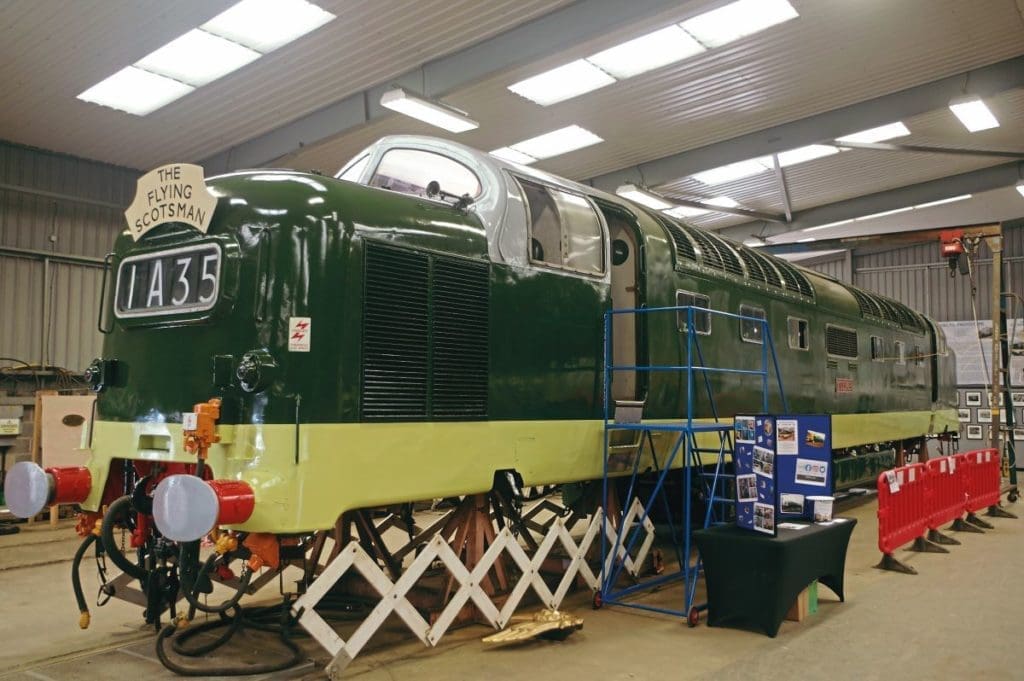
It has an enviable record as a versatile events venue, not only through its eagerly anticipated and hugely successful steam and modern traction galas, but also for holding music concerts, plays, and beer festivals, the next being Rail Ale 2023 on May 18-20.
The 20-acre site is also a thriving commercial railway business, with more than 60 people employed by several companies based on the site, not to mention several other heritage groups that have their home there – not least of all the Deltic Preservation Society, whose shed welcomed visitors during the gala.
Midland classics all together in one space
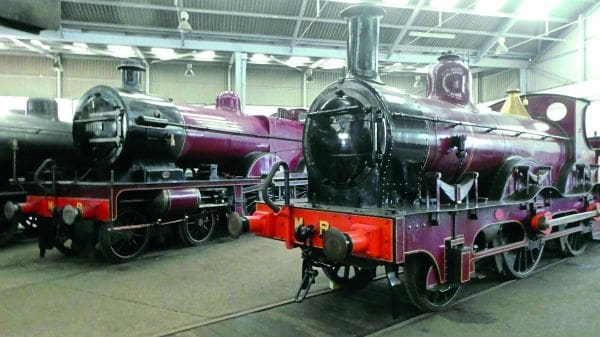
Plans to hold the 150th anniversary event in 2020 were dashed by the pandemic but the Roundhouse team would not concede defeat that easily. With its sizeable presence of visiting diesels from modern-day rail operators, the 150+2 Celebration Gala was designed to evoke the atmosphere of those BR public open days.
A team of about 100 volunteers worked around the clock to get the site ready for the three-day event, and more than 2000 visitors attended, including one person from as far away as Perth, Western Australia.
Visitors were able to get up close to the locomotives and visit cabs, and arts workshops were among several family activities also laid on. Side by side inside the roundhouse were two Midland Railway locomotives that had not been seen together for many years.
Barrow Hill Engine Shed Society, the charity responsible for the roundhouse, has signed a three-year loan agreement with the National Railway Museum to allow William Kirtley 2-4-0 No.158A to go on static display.
The locomotive, built at Derby Works in 1866, had previously been receiving conservation work and asbestos remediation at the Locomotion museum in Shildon.
Withdrawn in 1947, the following year it appeared at the Stephenson Centenary Celebrations at nearby Chesterfield. It became part of the National Collection in 1965 and was an exhibit at the Midland Railway – Butterley from 1975 until 2021.
Visitors to the 150+2 Celebration Gala saw it on display at Barrow Hill for the first time since its arrival, alongside Midland Compound 4P 4-4-0 No. 1000, which dates from 1902 and was the first original locomotive designed by Samuel Johnson.
Honouring football legends and a society magazine
The sole locomotive in steam during the gala was Hawksworth pannier No. 1501, visiting from Severn Valley Railway. It hauled passenger shuttles from Roundhouse Halt up the Springwell branch line in top-and-tail mode with home-based Class 03 No. 03066. Meanwhile, brake van rides were operated by privately-owned Class 02 D2868 and Class 07 No. 07012, both of which are based at Barrow Hill.
The Saturday was allocated as a special day for the Railway Correspondence and Travel Society, with GB Railfreight Class 69 No. 69003 (rebuilt from Class 56 No. 56018) renamed The Railway Observer, after the group’s monthly magazine. No. 69003 became the fourth locomotive to carry the magazine’s title, a tradition that began in 1994 with BR Railfreight petroleum sector Class 37 No. 37890 being named at Hither Green. When this moved to France, the title was passed to EWS No. 60001, which was duly named at Toton on February 23, 2001. Network Rail was later approached by a group of RCTS members and at Derby in June 2014, Class 43 HST power car No.43014 was named. It eventually formed part of the Network Rail Measurement Train. Network Rail chairman Sir Peter Hendy agreed the release of the nameplate from the power car so it could be fixed to the 69.

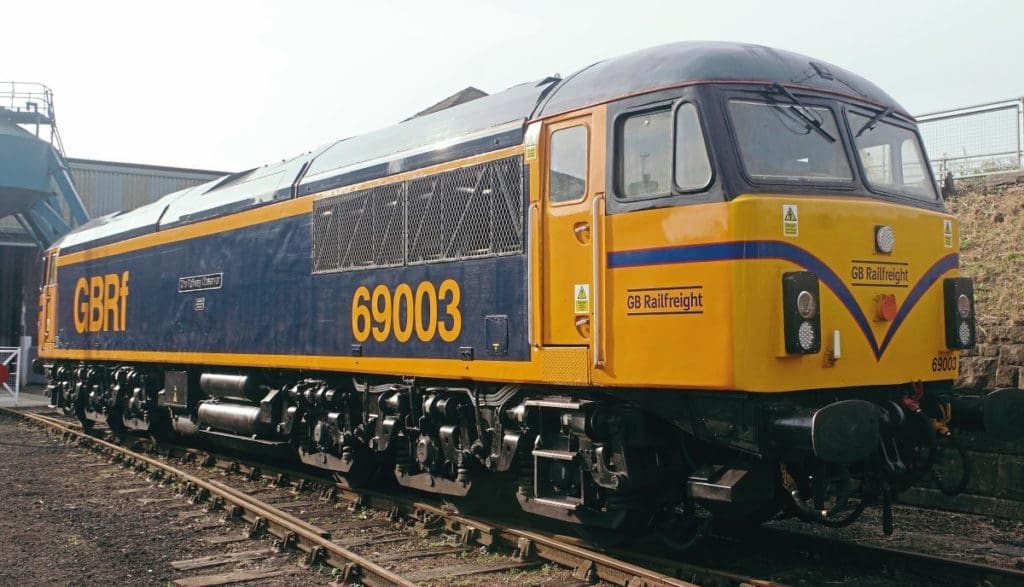
In a speech at the latest naming ceremony, GBRf engineering strategy director Bob Tiller declared his passion not only for sustainability and recycling/reuse that saw old Class 56s transformed into a new Class 69, but also for doing this in the UK using indigenous labour and expertise.
The day also saw the formal unveiling of the two RCTS-owned LNER B17/4 Footballer nameplates Sheffield United and Sheffield Wednesday, which had been on full visible display at Barrow Hill to the public up until that morning.
The unveiling was performed by John Pearson, a forward who played for Sheffield Wednesday between 1980 and 1985, making 105 appearances during which he scored 24 goals. John is now a commentator for Wednesday’s matches and had to leave the roundhouse early for Hillsborough as the team were playing at home later that day.
In attendance outside in the yard was GB Railfreight’s Class 66 No. 66726 Sheffield Wednesday. After the gala closed on the Sunday, No. 69 003 made its way to its normal base of Tonbridge West Yard.

A bright future inside the rail industry
In March, it was announced more than £25 million worth of projects in Chesterfield Borough Council’s Staveley Town Deal had been given the green light after the Government approved 11 of its proposed projects; one of which was the £5.1-million Derbyshire Rail Industry Innovation Vehicle centre, which will be built on land at the rear of the roundhouse.
The project is being led and developed by the council in partnership with Barrow Hill Roundhouse, Chesterfield College, the University of Derby, and Newcastle University. The Government will provide £3,735,000 of the funding and the council £790,000 in grant aid.
It will incorporate training spaces, offices, a digital laboratory and a large rail-connected workshop with the aim of creating local jobs and investment as a driving force behind the regeneration of a former industrial town.
In a meeting of the borough council’s Cabinet on June 21, skills delivery officer Emily Williams said: “It is hoped that through the provision of rail innovation training and additional commercial space that the project will position Barrow Hill and Staveley as a prominent location for rail technology, supporting social and economic regeneration of Barrow Hill, and bringing heritage and innovation together.”
Mervyn’s vision back in the late 1980s and the continuing achievements of BHESS led to him being awarded the MBE (Member of the Order of the British Empire) in the 2019 Queen’s New Year’s Honours list for his services to railway preservation and development.
➜ To hire Barrow Hill Roundhouse for an exclusive event, email [email protected]
Recreating a Baby Deltic

Taking centre stage on the roundhouse turntable was the Baby Deltic Project’s D5910, highlighting progress in its bid to recreate an example of one of the extinct Class 23s.
Ten Type B locomotives were ordered from English Electric under the pilot scheme for main line diesel locomotives as part of the BR Modernisation Plan of 1955. They were powered by a nine-cylinder Napier Deltic engine, and the first were delivered in spring 1959 and initially allocated to Hornsey depot.
Essentially prototype locomotives, all were withdrawn for refurbishment by June 1963, re-entering traffic within the next two years. However, all were withdrawn by March 1971 and scrapped apart from D5901, which was used at the Railway Technical Centre in Derby until March 1977 when it too was cut up, at Doncaster Works.
However, its power unit, No. 388, was claimed by the NRM and moved to York on August 16, 1977. This was rediscovered beneath a tarpaulin in January 2001 and subsequently bought by the recently-formed project team.
In September 2003, the power unit made its first public appearance, at Barrow Hill, and on October 22, 2008, after being stripped and rebuilt and temporarily mounted in a VDA van, it ran for the first time in three decades.
Around the same time, condemned for scrap, Class 37 No. 37372 was obtained.
The project to build a new Baby Deltic was launched on September 25, 2010. The plan was to shorten the body of No. 37372 in three places and mounting it on Class 20 bogies. It has been shortened in the middle by just over a metre and both noses have been shortened by half a metre. All the superstructure and body between the cabs has been replaced, the engine reinstalled, and the cab windows replaced. The ‘new’ locomotives has been mounted on newly-overhauled bogies which are indistinguishable from those on Baby Deltics. One nose has been restyled complete with original headcode discs and nose-end doors; the second nose is yet to be completed. Nothing remains from the donor 37.
➜ More details about the project can be found at babydeltic.co.uk
Advert
 Enjoy more Heritage Railway reading in the four-weekly magazine. Click here to subscribe.
Enjoy more Heritage Railway reading in the four-weekly magazine. Click here to subscribe.




